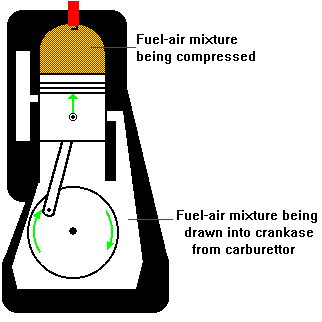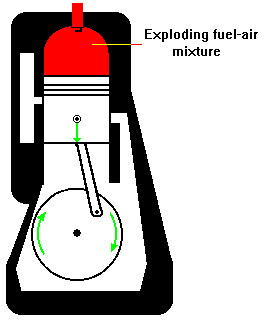First of all... let us dig deeper into the understanding of 2 stroke engines, how they work, how they are lubricated.
The following is taken from another source page with the link provided for your reference.
--------------------------------------------------------------------------------------------------------
Two-Stroke Engines
The two-stroke engine is mechanically very simple. There are no valves, camshafts, etc., just the piston connected by the con-rod to the crankshaft. Lubrication is achieved by mixing oil with the fuel, the resulting mixture then bathing all the moving parts. However, the complete cycle takes only one upstroke and one downstroke of the piston, so some elements of the four phases of operation must occur simultaneously.The fuel and air are mixed in the carburettor in the usual way, but instead of going directly to the top of the cylinder, the mixture enters the sealed crankcase, i.e. the space underneath the piston. The crankcase is connected to the combustion chamber in the cylinder by an inlet port, sometimes known as a transfer port. Opposite the inlet port there is another port, the exhaust port. Both the inlet and exhaust port are uncovered by the piston in the bottom part of its stroke, thus replicating the function of the valves in the four-stroke engine and allowing gases to enter and leave the cylinder. In the top part of the stroke both ports are covered, sealing the cylinder. This allows compression to occur at the top of the upstroke and allows the power of the expanding gases to be harnessed at the top of the downstroke.

Bottom of Downstroke - Induction/Exhaust
The piston has moved down, uncovering both the inlet (transfer) and exhaust ports. The descending piston has increased the pressure in the crankcase, so the fuel-air mixture is being pumped from the crankcase via the transfer port into the combustion chamber. In some engines (not in a Vire 7) there is a valve between the carburettor and the crankcase which stops any tendency for some of the fuel-air mixture to blow back through the carburettor.
Top of Upstroke - Compression
The piston has passed Bottom Dead Centre (BDC) and is now rising. The inlet and exhaust ports are both covered, so the fuel-air mixture in the combustion chamber is being pressurised and is heating up. At the same time, a vacuum is developing in the crankcase, so a fresh charge of fuel-air is being drawn into the crankcase from the carburettor. As the piston rounds TDC, a high voltage discharge from the spark plug ignites the mixture in the combustion chamber.
Top of Downstroke - Ignition/Power
With both ports still closed, the pressure of the expanding gases forces the piston down again. The pressure in the crankcase is already rising. Later in the downstroke the exhaust port will be uncovered, allowing the spent gases to escape. Very shortly after that the inlet/transfer port will also be uncovered, which takes the engine back to where it was at the start of the cycle.source: http://gofree.indigo.ie/~vire7/2stroke.htm
------------------------------------------------------------------------------------------------------------
How to treat a 2 stroke bike with GTO:
Step 1:
Every 2 stroke bike nowadays have what you call a 2T Auto lube tank. Check if this component is present in the system and check if it is working.
When this is present, working and is without a problem like leaks or faulty pump, fill the tank with your normal 2T fluid... once this tank is full, just add 15ml. of GTO (Green Technology Oil) into it. Stirring can help it to mix quickly with the rest of the fluid.
Step 2:
Then add another 15 ml. in the engine crank case. As you know, the oil in the engine crank case of a 2 stroke engine is not pumped all throughout inside the engine... it is only splashed as the crankshaft dips into the oil bath at every downstroke. However, this oil is not able to go on the top end section of the engine like the cylinder walls, this is why a 2 stroke engine needs the auto lube system to feed the cylinders and pistons at the same time the fuel and air is also fed into it when the engine starts to run.
Step 3:
It is a common bad habit and practice of most Philippine tricycle drivers to add 2T oil into the gas tank. They figured it would be safer to do it this way so the engine will not wear out easily. But to their little knowledge, the combustion efficiency of the engine as well as the emissions are compromised. Since fuel becomes dilluted with 2T oil, the fuel and air mixture becomes less volatile, causing the engine to emit so much smoke!... White smoke that is. This is the color of unburned oil.
In laymans term: A smoke belching 2 stroke means, low power but longer engine life due to excess oil in the cylinders.
The very same reason why this engine was banned in the first place... during the advent of Global Warming consciousness.
It is therefore imperative to remove the old fuel out of the system or out of the tank by draining it.
We will not be using this fuel anymore... but in order not to waste it, you may put it in the tank of your car.... since it will be diluted more, the 2T oil in it will be thinned out more....
Now put new 100% fuel (Gasoline/ Extra or Unleaded) into your motorbikes tank.
Now you're ready to run an ultra low emission 2 stroke bike!.
Consider changing your tail pipe into a more quiet one for your next stages.
God Bless and Enjoy the ride!
Hopefully, we can reverse the international move to ban all 2 stroke engines.
Empower yourselves... Adopt the Green Technology Program.

No comments:
Post a Comment